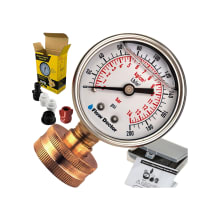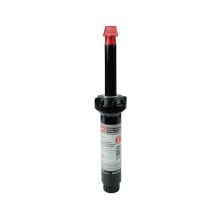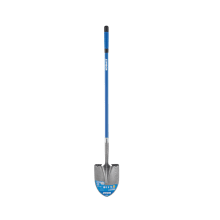How to install a DIY sprinkler system
With a little elbow grease, watering the grass can be easy
Products are chosen independently by our editors. Purchases made through our links may earn us a commission.
A beautiful lawn or garden is a point of pride for many people, but it can be hard to keep your landscape lush and lovely if you have to go out every couple of days and water by hand. Dragging an above-ground sprinkler to the middle of the lawn or vegetable patch is easier but easy to forget. An automatic sprinkler system is a fantastic solution, but those can be very expensive to install.
However, if your yard is set up right, the area is small enough, and you have enough water pressure, then a DIY sprinkler system shouldn't be that difficult. Depending on the size, it’s a project that some people can finish in as little as a weekend.
You can purchase a ready-to-install sprinkler package, but that limits you to only the options that different manufacturers decide to package together. If you want a bit more customization, you’ll need to do some planning and figure out the materials on your own. This opens up a world of possibilities for personalizing your sprinkler system to perfectly suit your yard and needs.
Each yard, home, and municipality is unique. This guide is merely a starting place. Before breaking ground, make sure you do thorough research, including investigating local codes covering sprinkler systems.
Tools needed
Materials needed
- Sprinkler heads
- PVC or flexible polyethylene pipe
- Couplers and fittings
- Caps
- Valves
- Valve boxes
- A timer
- A garden hose
- A backflow preventer
1. Check the flow rate and water pressure from your spigot
A DIY sprinkler system is only as good as the water feeding it, so before committing, ensure your water source is adequate for the number of heads and length of linen.
Flow rate is easy to find out. Simply time how long it takes to fill up a five gallon bucket and then calculate that to several gallons per minute. For example, if it takes 30 seconds to fill the bucket, your flow rate is 10 gallons per minute.
You’ll need to pick up a water pressure gauge to check the pressure. Follow the instructions of the one you buy, but generally, you screw it onto the spigot like you would a hose, turn the water on, and check the pressure reading.

Gauge your water pressure in order to pick the right sprinkler head and system.
2. Plan out your coverage map
There’s no point in going through the work of installing sprinklers just to find out that you missed a spot. To avoid dry patches in your lawn or dead stalks in your garden, plan your sprinkler head placement so that the spray patterns overlap by at least a foot or two.
As part of this planning, check with your local building department about the permits and code requirements for an irrigation system.
3. Select sprinkler heads that will work with your map and water
Now comes the tricky bit: finding a collection of sprinkler heads that will operate with your water pressure and flow rate and also achieve the results that you’re looking for. Water pressure will decrease as the sprinkler line continues, so don’t buy heads that require your home’s maximum water pressure.
If you have 70 PSI at the spigot, you want to keep more in the 30 PSI range, even if a massive 70 PSI head would cover more area, likewise for flow. If you’ve got 10 gallons per minute at the spigot, you can only feed sprinkler heads that add up to 10 or fewer gallons per minute.
The other consideration is the type of head. For lawns, you’ll likely want something that can shoot a long way in multiple directions, as well as heads that can retract so they don’t get destroyed by the mower.
If you’re watering a garden, you may want something that creates more mist or drip irrigation.
Tweak the map as you research heads until you get a plan that will work for you. Depending on your water needs, you may consider creating a system with multiple zones that operate at different times so you don’t overtax your system.

Factory-installed pressure regulator operates at a standard 30 PSI to prevent misting and water waste.
4. Select the rest of the materials needed
Once you complete the map, it's time to pick out the remaining components. Each DIY sprinkler system is unique, so you’ll have to decide precisely what is required. Here are some of the more common components most systems require:
- Underground sprinkler line, typically either PVC or flexible polyethylene or flexible polyethylene.
- Couplers and fittings to connect the heads to the sprinkler line
- Caps to terminate the ends of lines
- Valves to turn sections of the system on and off
- Valve boxes contain the valves underground but also give easy access to them.
- A timer so that you can set it and forget it
- A garden hose if the start of your sprinkler line is far from the spigot
- A backflow preventer to keep the water in your system from flowing into the house, which is often required by local building codes
5. Lay out and assemble your DIY sprinkler system above ground
The best-laid plans on paper are a great starting place, but reality typically requires a tweak or two. Before breaking ground, lay everything out, assemble everything, and check that the system works as you expected. You can sense the spray pattern here, though it won’t exactly match the final result when buried.
Also, double-check that your pressure and flow calculations are correct and that all sprinklers are getting enough water to run. You do not want to dig the system up because the last sprinkler in the line isn’t working.
6. Call Dig Safe
You can find out if there are any utility lines buried on your property by calling Dig Safe, which operates a free hotline in every state. Do this a few days before you dig anything. They will tell all utility companies to send someone out to your house to mark the lines so that you don’t accidentally break a water pipe, cut your internet, or kill the power.
7. Dig a ditch
It’s finally time to get to digging. There’s not much to this. Using a garden shovel, ensure that the trench is deep enough so that all of the sprinkler heads will be safe from the mower but not so deep that they’ll get buried and won’t be able to pop up when it’s time to turn on.
Generally, you want a trench eight to 12 inches deep.

Heavy gauge, tempered steel blade for increased strength and durability.
8. Lay out the sprinkler lines and test again
Since you already assembled the system, it shouldn’t take too long to get it into the ditch. Double check all the heights and adjust the trench or lines as needed. Once all the heads are in the final position, test the system again. This time, make sure that the water is reaching everywhere you need it to.
Adjust lines and angles of heads as needed for proper coverage.
9. Backfill your trench.
Use a shovel to backfill the trench once the sprinkler lines are placed where they should be.
Now, you’re good to go! Set your timer schedule, open up the appropriate valves, and sit back and enjoy a lusher lawn and fuller garden.


